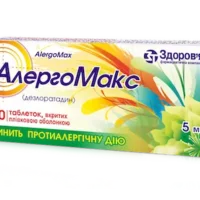Description
Erius Syrup 0.5 mg/ml. 60 ml. Vial №1
Composition
Erius syrup contains desloratadine as the active ingredient. It also includes inactive ingredients such as propylene glycol, sorbitol, citric acid, sodium benzoate, and purified water.
Mechanism of Action
Desloratadine, the active ingredient in Erius syrup, is a second-generation antihistamine that exhibits selective peripheral H1-antagonist activity. It works by blocking histamine receptors, thereby reducing allergic symptoms.
Pharmacological Properties
Erius syrup has antihistaminic properties, providing relief from symptoms of allergic rhinitis and chronic idiopathic urticaria. It has minimal sedative effects compared to first-generation antihistamines.
Indications for Use
Erius syrup is indicated for the relief of symptoms associated with allergic rhinitis (hay fever) and chronic idiopathic urticaria (hives) in adults and children.
Contraindications
Do not use Erius syrup if you are allergic to desloratadine or any of the inactive ingredients. It is contraindicated in children under 6 years of age.
Side Effects
Common side effects of Erius syrup may include headache, fatigue, dry mouth, and gastrointestinal disturbances. If any severe reactions occur, discontinue use and seek medical advice.
Usage Instructions
Shake the bottle well before each use. The recommended dosage for adults and children over 12 years is 2.5 ml (1.25 mg) once daily. For children aged 6 to 11 years, the recommended dosage is 1.25 ml (0.625 mg) once daily. Use the provided measuring device to ensure accurate dosing. Erius syrup can be taken orally with or without food.
Benefits Compared to Analogues
Desloratadine has been shown to provide effective relief from allergic symptoms with minimal sedation compared to first-generation antihistamines. Comparative studies indicate similar efficacy to other second-generation antihistamines but with a lower risk of causing drowsiness, making Erius syrup a preferred choice for individuals seeking non-sedating allergy relief.
Suitable Patient Groups
Erius syrup is suitable for use in adults and children over 6 years of age. It is well-tolerated and can be used by the elderly population as well.
Storage and Shelf Life
Store Erius syrup in a cool, dry place away from direct sunlight. Keep the bottle tightly closed. Check the expiration date on the packaging and do not use the product beyond that date.
Packaging Description
Erius syrup is available in a 60 ml vial with a measuring device for accurate dosing. The packaging is designed to maintain the integrity and stability of the product.
Clinical Evidence and Proven Effectiveness
Further research and clinical trials have demonstrated the safety and efficacy of desloratadine in the treatment of allergic conditions. Desloratadine has a rapid onset of action, providing quick relief from symptoms. It is considered a first-line treatment option for allergic rhinitis and chronic urticaria due to its effectiveness and favorable side effect profile.





